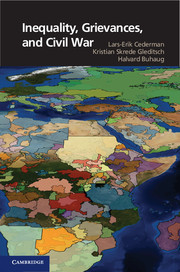Book contents
3 - From Horizontal Inequality to Civil War via Grievances
Published online by Cambridge University Press: 05 June 2014
Summary
What would it take to show that grievances actually do cause political violence? In Chapter 2, we noted that it is difficult to measure grievances directly, at least if the empirical scope encompasses a large number of cases. Therefore, we opt for an indirect approach that identifies conditions under which grievances are likely to emerge. In particular, we posit that inequalities among groups correspond to such situations, and proceed by investigating whether they are related to the outbreak of civil war in the empirical chapters to follow. In this chapter, we propose a combination of theoretically grounded mechanisms that together constitute a causal pathway that connects inequalities with violent conflict through grievances. Without a direct test of the grievance mechanisms themselves, it is all the more important to bolster their credibility by showing that they can be derived from conceptually coherent and empirically validated theories.
The main goal of this chapter is to construct a theoretical scheme that explains how inequalities cause violent conflict. Before doing so, however, it is appropriate to briefly introduce two key types of inequalities and their historical origins.
Vertical and Horizontal Inequalities
Our first task is to conceptualize inequality as a structural, asymmetric condition governing social relations among actors. Given Charles Tilly’s role as a prominent critic of grievance-based theorizing in general, and relative deprivation theory in particular, it may seem surprising to use one of his works as an initial source of inspiration for our theorizing. Yet, Tilly’s (1999) provocative book on Durable Inequality is a useful conceptual starting point because it helps overcome the problems afflicting the conventional conflict literature.
- Type
- Chapter
- Information
- Inequality, Grievances, and Civil War , pp. 30 - 54Publisher: Cambridge University PressPrint publication year: 2013



